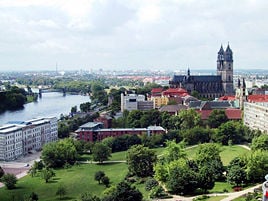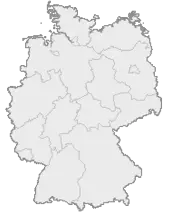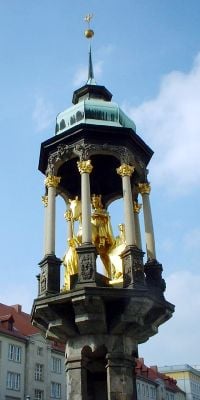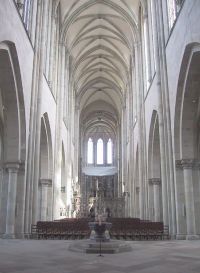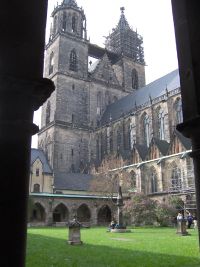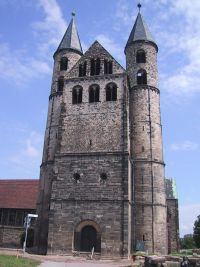Magdeburg
Magdeburg, the capital city of the Bundesland of Saxony-Anhalt, Germany, lies on the Elbe River and was one of the most important medieval cities of Europe. Emperor Otto I, the first Holy Roman Emperor lived during most of his reign in the town and was buried in the cathedral after his death. Magdeburg's version of German town law, known as Magdeburg rights, spread throughout Central and Eastern Europe. The city is also well-known for the 1631 Sack of Magdeburg, which hardened Protestant resistance during the Thirty Years' War. GeographyGeogrpahically, Magdeburg is situated on a large flat plain, with much of the city lying along the left bank of the Elbe River. Structurally, Magdeburg consists of the main city hub, with five large subburbs nearby. The five suburbs: Friedrichstadt, Wilhelmstadt, Neustadt, Sudenburg and Buckau are seperated from the city proper, especially Wilhelmstadt, Neustadt, Sudenburg and Buckau that are divided from the main urban center by a series of geographic grooves that were cut into the earth during glacier movements. The city, and the suburbs, are distinguished by small, windy streets that wind throughout the city. The only exception to this rule is Breite Weg, a large road that runs directly north from south through the main center of town. The weather of Magdeburg is extrememly variable reagrding tempature and rainfall. While the tempatures can dip as low as 32° Farenheit in the winter months, summers can be sweltering. When the temaptures reach 80° Farenheit, rainfall also increases in the area, rising to a high of approximmately 8 inches a month. Rainfall and the heat combine to make the summer months particularly difficult for outdoor activities. For this reason, the tourist season in Magdeburg runs from early fall to early winter. EconomyThe industry of Magdeburg is ehavily based on large scale industrial exportation. Key industries in the area include sugar refining and chicory production, both of which take place on an extrememly large industrial scale. Smaller industries include tobacco production, chocolate production, and varnish formulation. Like many cities in Germany, Magdeburg also boasts a variety of distilleries and breweries. In matters of agricultural production, Magdeburg produces a large variety of cereals, fruits and other vegetables. In addition, Magdeburg hosts large herds of cattle and horses. Wool, cloth, and leather are key exports in regards to textiles. Magdeburg continues to be a large export economy to the modern day, a fact that is supported by a recently made man made harbor. The new winter horbor, built to facilitate traffic along the Elbe, is estimated to process roughly 3 million tons of merchandise a year. HistoryThe city of Magdeburg first entered the written record as a fortified town of emporer Charlemagne. In order to defend against Hungarian and Slavic invaders the small fishing village was quickly transformed into an extrememly stong defensive position. Later emporers, like King Henry I, also followed the trend and chose Magdeburg as a defensive position. The fortress was given to Edward the Fowler's daughter Edith as a wedding present. According to historical records, Edith loved the city so much that she chose to be burried in the parish churchyard. From its early legacy as a military fortress, Magdeburg become a center for religious study in the around 900 C.E. At this time the Archbishopic of Magdeburg was founded, faciliating the rise of Magdeburg as a religious power. Adalbert of Magdeburg recieved the archbishopship, effectively gaining control of the Havelberg, Brandenburg, Merseburg, Meissen, and Zeitz-Naumburg. Probably due to its rising signifigance in the religious scene, Magdeburg was granted a patent to hold trade exhibits and conventions in 1035 C.E. As a result of this patent, Magdeburg combined its rising religious authority with economic clout, becoming a major urban center in early Germany. Despite the promise of Magdeburg; however, all hopes almost came to a crashing halt in 1118 when a fire ravaged the city. Luckily, Magdeburg was able to recover from the effects of the fire, and joined the Hanseatic League in the early 13th century C.E. It is important to note that, even after the dehabilitating fire, Magdeburg was counted as one of the cities with a population numbering over 20,000 inhabitants in the Holy Roman Empire. As a major rising metroplis, Magdeburg soon attracted a series of religious dissidents who sought the large audiences of an urban center. One rising dissident. Martin Luther, was attracted to the rising urban center, and began to lecture in the city in 1524 C.E. Almost immediately, Martin Luther gained a large gathering of followers, and soon drew the attention of Emperor Charles V. The young preacher was seen as a challenge to the authority of the church, and the city was repeatedlky outlawed by the religious authorities. In the moment that encapsulated the church's resistence to the unconventional ideas of Magdeburg, the city was beseiged from 1550 to 1551 by the emporer's troops. Resistence to imperial power, which was coupled with offical relgious ideaology, Magdeburg maintained its religious and political independence. Due to the military resistance of the emporer's invasion, Magdeburg gained a worldwide repuation as a center for religious tolerance and Protestant relgious growth. To celebrate their new religious freedom, Magdeburg soon published the writings of the dissident, and politically disavowed, Martin Luther. Martin Luther felt that the Catholic church had become corrupt, and had lost sight of its religious ideals.  Magdeburg's center has numerous Stalinist neo-classicist buildings. The independence of Magdeburg soon began to faulter, as the religious city coudl not maintain its ideaologicl independence in the face of political threats. The first blow to strike Magdeburg, the Thirty Year's War, pitted the military strength of Magdeburg against the troops of the Holy Roman Empire. The Holy Roman Empire forces eventually triumphed, committing a massacre where the imperial troops killing 20,000 inhabitants of the city. After the devastating struggle of the war, it is reported that only 400 individuals remained in the city. The political power of Madgeburg was completely destroyed as a product of the war, and the city was given to Brandenburg-Prussia in the treaty of Westphalia. The Napoleonic Wars were also detrimental to the indepedence of Magdeburg, as the city was quickly surrendered to French troops. After the Napoleaonic War, Madgeburg was made capital of the new Kingdom of Prussia, and while politically important, was not autonomous. World War II was devastating to the small urban city of Magdeburg. Many of the historical buildings were destroyed, and the city suffered extrememly large population losses. Allied firebombing, a new technique at the time, guaranteed that the city remained virtually uninhabitable after the war. By most reports it is stated that the damamge to Magdeburg was second only to Dresden in matter of devastation during World War II. Partially due to the fact that Magdeburg was completely devastated during the war, the rebuilding of the city was seen as a matter of nationalistic pride after the war. Following german reunification the new, and rebuilt, Magdeburg became capital of the newly formed state od Saxony-Anhalt. CathedralMagdeburg's most impressive building, the Cathedral of Saints Catherine and Maurice, has a height of 104 m: the highest church building of eastern Germany. It is notable for its beautiful and unique sculptures, especially the "Twelve Virgins" at the Northern Gate, the depictions of Otto I the Great and his wife Editha as well as the statues of St Maurice and St Catherine. The statue of St Maurice (ca. 1250) is one of the few where Maurice is displayed as a black man with African features holding a sword and wearing chainmail. This is surprising, in light of the fact that Maurice was an Egyptian. It is in fact the oldest depiction of a black person in Europe. St Catherine is dressed like a young teenage girl from the time of the statue's creation would have been - the equivalent to a girl in jeans and T-Shirt today. (Quite a scandal then.) The predecessor of the cathedral was a church built in 937 within an abbey, called St. Maurice. Emperor Otto I the Great was buried here beside his wife in 973. St. Maurice burnt to ashes in 1207. The exact location of that church remained unknown for a long time. The foundations were rediscovered in May 2003, revealing a building 80 m long and 41 m wide. The construction of the new church lasted 300 years. The cathedral of Saints Catherine and Maurice was the first Gothic church building of Germany. The completion of the steeples took place only in 1520. While the cathedral was virtually the only building to survive the massacres of the Thirty Years' War, it nevertheless suffered damage in World War II. It was soon rebuilt and completed in 1955. The place in front of the cathedral (sometimes called "new marketplace," Neuer Markt) was occupied by an imperial palace (Kaiserpfalz), which was destroyed in the fire of 1207. The stones of the ruin served for building the cathedral. The presumptive remains of the palace were excavated in the 1960s. Other sights
Magdeburg is one of the major towns along the Elbe Cycle Route (Elberadweg). Twin towns
People and CultureReferences
|
||||||||||||||||||||||||||||||||||||||||||||||
